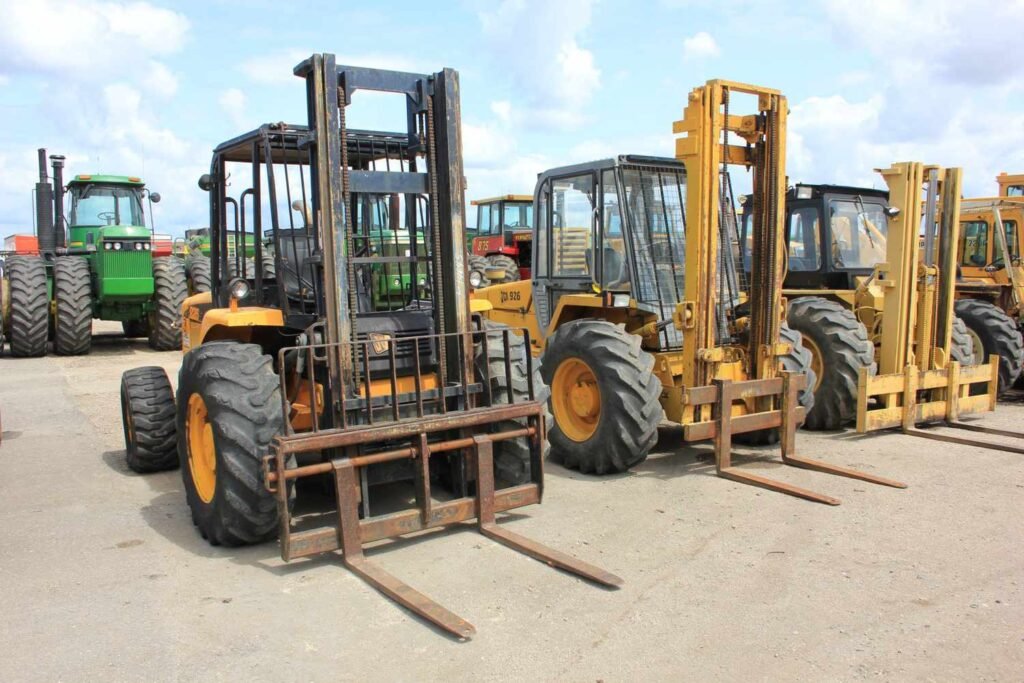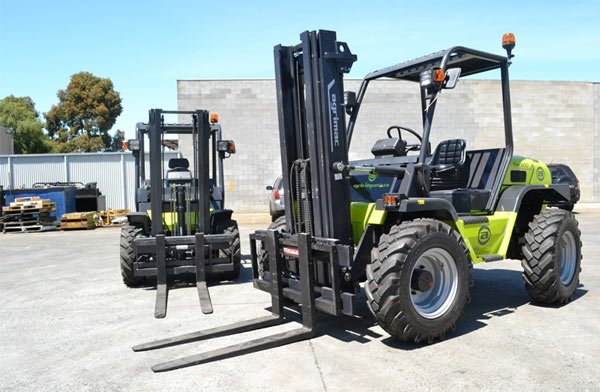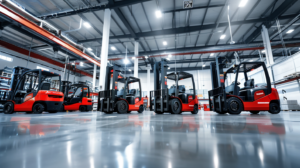Starting a forklift rental business can be a profitable venture—especially with the growing demand in the logistics, construction, and manufacturing sectors. But just like any other business, there are crucial elements you must understand to ensure success. This guide explores everything from startup costs to customer service, giving you a comprehensive overview of what to expect.

Understanding the Forklift Rental Market
Current Industry Trends
The forklift rental market is growing steadily due to increased demand in warehousing, e-commerce, and construction. Many companies now prefer renting equipment rather than buying, as it reduces capital expenditures and maintenance headaches.
Target Customers (Construction, Warehouses, etc.)
Your primary customers may include:
- Construction companies needing short-term use
- Warehouses during peak seasons
- Event management firms for setup tasks
- Retail chains with distribution centers
Knowing your customer base helps tailor your offerings and marketing strategy.
Market Demand and Seasonality
Forklift rentals often peak during certain times—like holiday seasons or end-of-quarter logistics pushes. Being aware of this pattern allows for better inventory management and targeted promotions.
Legal Requirements and Licenses
Business Registration
Before anything else, register your business legally. Choose the right structure—LLC, sole proprietorship, etc.—based on liability and tax implications.
Local Permits and Zoning Laws
Some areas have zoning regulations prohibiting industrial equipment businesses in residential or commercial zones. Always verify with your local municipality.
Safety Regulations and Compliance
You’ll need to comply with OSHA (Occupational Safety and Health Administration) standards and local safety laws. Non-compliance could result in heavy fines and business disruption.
Types of Forklifts to Offer
Electric vs. Diesel Forklifts
Electric forklifts are suitable for indoor use due to zero emissions, while diesel models are preferred for outdoor heavy-duty operations.
Counterbalance, Reach Trucks, and Others
Depending on your customer’s needs, stock a variety of types:
- Counterbalance Forklifts – Standard model
- Reach Trucks – Ideal for warehouse aisles
- Pallet Jacks – Simple lifting tasks
- Telehandlers – For construction and rough terrain
Selecting Models Based on Customer Needs
Choose versatile and in-demand models. Research brands with a reputation for durability and performance like Toyota, Hyster, and Caterpillar.

Start-up Costs and Capital Investment
Buying vs. Leasing Forklifts
Buying gives you full control, but leasing lowers upfront investment. A mix of both can be an effective strategy.
Insurance Costs
Insurance is mandatory to protect your assets. Expect to pay based on equipment value and usage risks.
Maintenance and Storage Facility
You’ll need a secure place to store and maintain your forklifts. This could be a rented warehouse or land zoned for industrial use.
How to Set Competitive Rental Rates
Hourly, Daily, and Weekly Pricing
Offer multiple pricing structures to accommodate different customer needs.
Rate Comparison with Competitors
Research local competitors and keep your rates competitive, but also sustainable.
Discounts and Bulk Rental Packages
Incentivize repeat business with packages and loyalty discounts. Offer corporate rates to large clients.
Building a Rental Agreement
Terms and Conditions
Always include:
- Usage hours per day
- Return time and condition
- Security deposit requirements
Damage Liability Clauses
Clearly define who pays for repairs and under what conditions. This limits disputes and protects your business.
Return Policies and Late Fees
Have set fees for late returns or extended usage without prior agreement.
Insurance and Risk Management
Business Liability Insurance
Covers bodily injury and property damage. It’s vital when operating heavy machinery.
Equipment Insurance
Protects against theft, vandalism, or major breakdowns.
Risk Mitigation Strategies
Implement strategies such as:
- GPS tracking
- Driver training verification
- Safety protocols

Maintenance and Safety Checks
Scheduled Maintenance Plans
A forklift rental business must ensure each machine is in peak operating condition. Implement regular scheduled maintenance to reduce breakdowns and prolong equipment life. Create a checklist for monthly, quarterly, and annual service tasks.
Daily Pre-use Checks
Encourage or require customers to perform daily checks before operation. These should include:
- Fluid levels
- Tire condition
- Hydraulic systems
- Fork and mast integrity
Providing customers with a quick inspection guide adds professionalism and minimizes damage claims.
Working with Certified Technicians
Use certified mechanics for repairs and maintenance. This guarantees quality work and builds credibility with clients who depend on reliable equipment.
Storing and Transporting Forklifts
On-site Storage Options
Secure, covered storage is crucial. Forklifts are valuable and prone to theft or damage if left unprotected. Consider investing in a facility with 24/7 surveillance and access controls.
Forklift Transportation Logistics
Transporting heavy equipment requires flatbed trucks or trailers. Decide whether you’ll outsource this to logistics companies or manage your own fleet for pickups and drop-offs.
Delivery and Pick-up Services
Offering transportation as a value-added service can attract more clients. Provide options like same-day delivery, after-hours service, or weekend availability for a premium fee.
Marketing Your Forklift Rental Business
Online Advertising (Google, Facebook)
Digital ads help generate leads fast. Google Ads allows targeting by location and keywords, while Facebook lets you reach businesses by industry.
Local Outreach and Networking
Build relationships with construction companies, logistics firms, and industrial parks. Attend trade shows and distribute flyers to local warehouses and business hubs.
SEO and Website Presence
Your website should:
- List all available forklift models
- Allow online bookings or inquiries
- Include customer testimonials
- Be optimized for search engines with keywords like “forklift rental near me” and “affordable forklift rental”

Using Technology for Efficiency
Inventory Management Software
Software helps track:
- Current rental status
- Maintenance schedules
- Damage history
- Rental income per unit
Popular tools include Fleetio, Quipli, and Rentrax.
Online Booking System
Let customers schedule rentals via your website. Automate confirmations, invoices, and availability calendars.
Fleet Tracking Tools
Install GPS trackers to monitor location, usage, and theft. Real-time data improves accountability and operational efficiency.
Hiring and Training Employees
Recruitment Strategy
Hire skilled professionals, especially for maintenance and logistics. Use job boards, staffing agencies, or referrals.
Forklift Training and Certification
Anyone operating your forklifts—whether staff or clients—must be properly trained and certified. Provide certification options or partner with local training centers.
Customer Service Skills
Your employees should be:
- Knowledgeable about each model
- Friendly and responsive
- Trained to resolve conflicts and complaints
Customer Relationship Management
Building Repeat Clientele
Loyalty programs, discounts for repeat customers, and excellent service are key to building a returning client base.
Handling Complaints and Feedback
Have a clear feedback process. Respond quickly to issues and document them for quality improvement.
Loyalty and Referral Programs
Offer incentives for referrals—like a discount on the next rental—for businesses that bring in new clients.

Taxation and Accounting
Invoicing and Payment Tracking
Use accounting software like QuickBooks or Xero to manage:
- Customer invoices
- Late payments
- Receipts and refunds
Depreciation of Equipment
Track asset depreciation for accurate financial reporting and tax deductions. Forklifts lose value annually and this should be reflected in your books.
Working with a Tax Professional
Tax regulations vary by region. Hiring a CPA familiar with equipment rentals ensures compliance and maximized write-offs.
Environmental Considerations
Eco-Friendly Equipment
Electric forklifts are not only better for indoor use but also reduce your carbon footprint. Advertise this advantage to attract eco-conscious clients.
Waste Disposal Regulations
Dispose of oil, batteries, and old parts responsibly. Local environmental laws may impose fines for improper disposal.
Green Business Practices
Offer digital invoices, use solar-powered facilities if possible, and recycle materials to improve your public image.
Scaling the Business
Expanding the Fleet
As your business grows, reinvest in higher-capacity or specialty forklifts. Analyze usage data to prioritize the most rented models.
Branching into New Locations
Consider opening a new branch if:
- Your current location hits capacity
- Demand exists in nearby cities
- You have the logistics to support it
Partnership Opportunities
Collaborate with construction firms, logistics companies, or event organizers. Partnerships can lead to long-term rental agreements.

Common Challenges in Forklift Rental
Equipment Damage
Minimize risk by:
- Using rental checklists
- Taking before-and-after photos
- Charging security deposits
Unpaid Rentals
Implement strict rental terms and upfront payments. Use contracts to enforce payment timelines and pursue collections if needed.
Seasonal Slumps
During off-peak months, offer promotions, diversify your clientele, or explore alternative rental markets like festivals and outdoor events.
Regulatory Changes to Watch
OSHA Updates
Stay informed about OSHA guidelines, which may change forklift operation protocols or safety requirements.
Emission Standards
New environmental laws could affect diesel-powered forklifts. Plan ahead by gradually introducing electric models.
Licensing Modifications
Your staff or even your fleet may need updated certifications depending on local transportation or labor regulations.
KPIs to Track Business Success
Rental Utilization Rates
Indicates how often each forklift is in use. A low rate might suggest you need better marketing or a smaller fleet.
Profit Margins
Track income vs. expenses to determine profitability. Adjust rental rates or cost structure as needed.
Customer Satisfaction Scores
Use surveys or Google reviews to gather feedback. Positive reviews enhance your credibility and attract new business.
Industry Best Practices
Standard Operating Procedures
Document clear processes for:
- Equipment handoffs
- Maintenance routines
- Customer communication
Customer Education
Provide quick guides or video tutorials for first-time renters. This reduces misuse and improves safety.
Benchmarking Competitors
Regularly analyze your competitors’ pricing, services, and customer feedback. Stay competitive by refining your own offerings.

FAQs About Forklift Rental Business
1. How much does it cost to start a forklift rental business?
Starting costs vary but typically range from $100,000–$300,000 depending on fleet size, storage, and transportation setup.
2. Is a forklift rental business profitable?
Yes. With proper management and high equipment utilization, ROI can be strong within 2–3 years.
3. Do I need a license to rent forklifts?
You may not need a special license to rent them out, but operators must be certified under OSHA regulations.
4. What types of forklifts are best for rentals?
Versatile models like electric counterbalance forklifts and pallet jacks are high in demand for various industries.
5. How can I attract new customers?
Invest in SEO, Google Ads, and partner with construction companies. Offer discounts for first-time rentals.
6. What should I include in a forklift rental agreement?
List equipment details, rental duration, payment terms, liability clauses, and return conditions.
Conclusion
Starting a forklift rental business isn’t just about having equipment—it’s about understanding your market, maintaining safety and compliance, offering exceptional customer service, and adapting to industry trends. With thorough preparation and ongoing improvement, your business can lift off—pun intended—and thrive in a competitive market.





